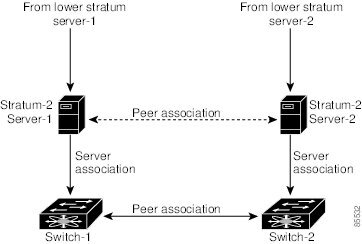- Cisco Community
- Technology and Support
- Networking
- Switching
- NTP few questions
- Subscribe to RSS Feed
- Mark Topic as New
- Mark Topic as Read
- Float this Topic for Current User
- Bookmark
- Subscribe
- Mute
- Printer Friendly Page
- Mark as New
- Bookmark
- Subscribe
- Mute
- Subscribe to RSS Feed
- Permalink
- Report Inappropriate Content
09-08-2012 11:36 AM - edited 03-07-2019 08:46 AM
Hi everybody.
Please consider the following output.
ntp_clent#show ntp associations address ref clock st when poll reach delay offset disp* 206.191.241.44 128.194.103.14 5 7 8192 76 4.1 0.05 910.5 * master (synced), # master (unsynced), + selected, - candidate, ~ configuredntp_clent#
That is the image I have on mind based on the above output.
ntpClient--------------ntpserver(206.191.241.44) at str-5--------ntpserver-str4---ntpserver-str3---nppserver-str2--ntpserver-str1--reference clock.
1)Did I visualize it correctly?
2)The ip address 128.194.103.14 belongs to ntp server directly connected to reference clock right?
3)Delay 4.1 in above output shows the total delay i.e time request to travel to ntp server and back to ntp client ?
thanks and have a great weekend.
Solved! Go to Solution.
- Labels:
-
Other Switching
Accepted Solutions
- Mark as New
- Bookmark
- Subscribe
- Mute
- Subscribe to RSS Feed
- Permalink
- Report Inappropriate Content
09-08-2012 01:25 PM
Hi Sarah,
Yes, you are correct an all questions:
NTP uses a stratum to describe how many NTP hops away that a network device is from an authoritative time source. A stratum 1 time server has an authoritative time source (such as an atomic clock) directly attached to the server. A stratum 2 NTP server receives its time through NTP from a stratum 1 NTP server, which in turn connects to the authoritative time source.
Also, this document explains each files from "sh ntp asso" command:
http://www.cisco.com/en/US/products/sw/iosswrel/ps1818/products_tech_note09186a008015bb3a.shtml
HTH
- Mark as New
- Bookmark
- Subscribe
- Mute
- Subscribe to RSS Feed
- Permalink
- Report Inappropriate Content
09-08-2012 04:16 PM
I haven't seen (for quite awhile) anyone using the "ntp peer" command. It's always been "ntp server".
Cisco does NOT recommend using "ntp master" as this could tell the appliance to say, "Hey, don't trust anyone else. I AM the NTP KIIIIIIIIIIIIIIING!" ... even though the time/date is incorrect.
- Mark as New
- Bookmark
- Subscribe
- Mute
- Subscribe to RSS Feed
- Permalink
- Report Inappropriate Content
09-08-2012 01:25 PM
Hi Sarah,
Yes, you are correct an all questions:
NTP uses a stratum to describe how many NTP hops away that a network device is from an authoritative time source. A stratum 1 time server has an authoritative time source (such as an atomic clock) directly attached to the server. A stratum 2 NTP server receives its time through NTP from a stratum 1 NTP server, which in turn connects to the authoritative time source.
Also, this document explains each files from "sh ntp asso" command:
http://www.cisco.com/en/US/products/sw/iosswrel/ps1818/products_tech_note09186a008015bb3a.shtml
HTH
- Mark as New
- Bookmark
- Subscribe
- Mute
- Subscribe to RSS Feed
- Permalink
- Report Inappropriate Content
09-08-2012 03:59 PM
Thanks Reza.
I am a little confused about the term " peer" used in the forwarded links.

1) Peer association provides redundancy .
2) Can we establish peer relationship between switch-1 and server-2 using ntp peer command? ( I understand better choice would be to configure sw1 to point to server-2,but just out of curiosity, is it possible)
=======================================================================================
I noticed that another link you forwarded uses the term" peer" to refer to ntp server. For e.g
Router#show ntp associations address ref clock st when poll reach delay offset disp ~172.31.32.2 172.31.32.1 5 29 1024 377 4.2 -8.59 1.6 +~192.168.13.33 192.168.1.111 3 69 128 377 4.1 3.48 2.3 *~192.168.13.57 192.168.1.111 3 32 128 377 7.9 11.18 3.6 * master (synced), # master (unsynced), + selected, - candidate, ~ configured
If there's an asterisk (*) next to a configured peer, then you are synced to this peer and using them as the master clock. As long as one peer is the master then everything is fine.
3)Do we use the word " peer" to mean any ntp server which the local router/switch uses to synchronize its clock with ? i.e it does not mean there is peer relationship configured between the two using ntp peer IP-ADDRESS command.
thanks for your help and enjoy your weekend.
- Mark as New
- Bookmark
- Subscribe
- Mute
- Subscribe to RSS Feed
- Permalink
- Report Inappropriate Content
09-08-2012 04:16 PM
I haven't seen (for quite awhile) anyone using the "ntp peer" command. It's always been "ntp server".
Cisco does NOT recommend using "ntp master" as this could tell the appliance to say, "Hey, don't trust anyone else. I AM the NTP KIIIIIIIIIIIIIIING!" ... even though the time/date is incorrect.
Discover and save your favorite ideas. Come back to expert answers, step-by-step guides, recent topics, and more.
New here? Get started with these tips. How to use Community New member guide